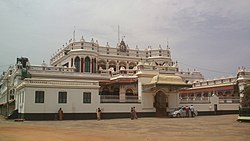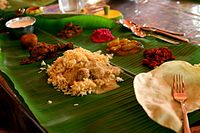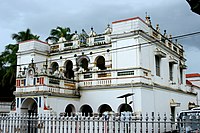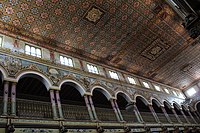Chettinad
Chettinad (also known as Chettinadu) is a region located mainly in the Sivaganga district historically ruled by Ramnad kingdom of Pandya Nadu and has a small portion extending into the Pudukottai District in Tamil Nadu, India.[citation needed].Karaikudi and Devakottai are the Major Towns of this Area
Etymology[edit]
The name means "land (nadu) of the Chettiars".[1]
Demography[edit]
In the 19th and early 20th centuries, many residents of Chettinad were trading in South and Southeast Asia, particularly Burma, Ceylon, Vietnam and Malaysia. By 2010, only 74 villages remained of the original 96,[2] organized in clusters spread over a territory of 1,550 square kilometres (600 square miles) in the Districts of Sivagangai and Pudukottai in the State of Tamil Nadu. It finds itself in the UNESCO nomination for palatial house sites of historic and cultural value.[3]
Community[edit]
Chettinad is the home of the Nattukottai Chettiars (Nagarathar), a prosperous banking and business community and for high hierarchy, non-Brahmin Vallambar feudal community with an aristocrat title Nattar - Ambalam. It is also known for its local cuisine, architecture, and religious temples.[4]
Chettinad cuisine[edit]
The word "Chettiar" refers to the social caste of mercantile bankers. The Chettiars are known to be traders in salt and spices and this is reflected in the Chettinad cuisine. Meals also consist of cooked lentils, Brinjal curry, drumstick sambar, ghee for flavouring rice, and sweet meals like payasam and paal paniyaram. In general, beef and pork dishes are not served. Some well-known local dishes are Chicken Chettinad (spicy chicken curry), Vegetable Chettinad (a vegetable curry) and dishes featuring seafood.
Architecture[edit]
Kanadukathan Chettinadu Palace entrance
The Chettinad region is well known for its 19th-century mansions, whose wide courtyards and spacious rooms are embellished with marble and teak. Construction materials, decorative items, and furnishings were mostly imported from East Asian countries and Europe. The marble was brought from Italy, chandeliers and teak from Burma, crockery from Indonesia, crystals from Europe and wall-to-wall mirrors from Belgium.
Many of these mansions were built using a type of limestone known as karai.[5] According to locals the mansion walls were polished with a paste made out of egg whites and palm sugar to give them a smooth texture and for their cooling qualities.[citation needed]
Temples[edit]
Originally built by early Tamil dynasties like the Cholas, the temples of Chettinad stand testimony to the spiritual beliefs of local people. Temples are built per Vaastu Shastras and Agamas as the Chettinad wealthy sponsored the buildings and the shilpis after the royal families declined. On the side note, traditional houses were also built per ancient text on an architecture called Vaastu Shastras.
Each temple has its own tank called oorani where water lilies are grown and used for holy rituals. Even today, much of Chettinad's daily activities are centered around the festivities of the temple. Among the many famous temples are: Vairavan Kovil, Iraniyur, Karpaga Vinayakar, Kundrakudi Murugan, Kottaiyur Sivan, and Kandanur Sivan temples, with each having its own unique deity.[6][7]
Vinayagar Chathurthi is celebrated every year, on the day when the two stars Shasti and Sadhayam mingle together. This day typically falls as the 22nd day after Periya Karthigai. Pillaiyar Nonmbu, its name, is usually in the month of December. On this day, they sing songs of the deity Lord Vinayagar and then take a sweet called Ellai.[6]
Local crafts[edit]
Sari[edit]
The cotton sari, also known as kandaangi, is unique in its dramatic patterns and colors.[8] Its vibrance and weight are its distinguishing factors. Records and old photographs show the use of sari by previous generations, before the advent of blouses and underskirts, and thus worn rather differently from the typical contemporary sari. At present, it is available in Kundi.
Aathangudi tiles[edit]
Athangudi tiles, named after the place of the manufacture in Chettinad, come in a myriad of colours and patterns, and are made by a unique process using local soil and glass plates.[9] These tiles are a testament to the rich cultural heritage of the Chettiar community, who effectively adapted many influences to their own brand of local craftsmanship. The designs and colours used in Athangudi tiles are still those of a bygone era. However, of late, new designs and patterns are being incorporated.
The Athangudi tiles are hand-made. However, with a short shelf life and relatively slow manufacturing process, these tiles are not much in demand. The situation has led to the decline in the market.
Industry[edit]
Chettinad's principal town, Karaikudi is also the location of a branch of the Central Electro Chemical Research Institute (CECRI), one of the forty national laboratories under the aegis of the Council of Scientific and Industrial Research (CSIR) in New Delhi. The CSIR lab specializes in electro-chemical research and has been operational for more than fifty years. The campus is on over 300 scenic acres, filled with traditional and ornamental vegetation.[10] CECRI conducts four-year Engineering and Technology courses in chemical and electro-chemical engineering and technology affiliated with the Anna University in Chennai.
Travel[edit]
The nearest airports are Madurai Airport and Tiruchirappalli International Airport while the largest towns in the area are Karaikudi and Devakottai. Trains that run from Chennai to Rameshwaram stop at Pudukkottai, Karaikudi, Kanadukaathan (Chettinad Station), Devakottai and Kallal. Karaikudi Junction railway station is the major station. Karaikkudi and Aranthangi railway station. There are also frequent town buses connects Chettinad to Karaikudi, Ponnamaravathy, Devakottai Pudukkottai and Aranthangi.
Notable people[edit]
- Alagappa Chettiar - founder of the various educational institutions in Karaikudi and its surroundings. Alagappa University, Alagappa Chettiar College of Engineering and Technology, and Alagappa Government Arts College are a few institutes named in his honour.
- Annamalai Chettiar - founder of Indian Bank and the Annamalai University bears his name.
- Muthiah Chettiar
- S. Rm. Muthiah Chettiar
- M. A. M. Muthiah
- M. A. M. Ramaswamy
- M. A. Chidambaram
- P. Chidambaram - former Finance Minister of India.
- Kaviarasar Kannadasan - Tamil poet.
- Justice A. R. Lakshmanan (b. 1942) - former judge of the Supreme Court of India and current chairman of the Law Commission of India.
- Lena Chettiar
- A. V. Meiyappan - founder of AVM Productions, the oldest and largest film production studio in Kollywood, the Tamil language film industry of India.
- Hari Sevugan
- Rama Narayanan, film director and producer
- Sp Muthuraman, film director and producer
- Vasanth, director
- Soma Valliappan
References[edit]
- ↑ Heritage Holidays. India: Outlook Publishing. 2004. p. 409. ISBN 978-81-901724-5-5. Archived from the original on 22 January 2023. Retrieved 10 September 2020.
Chettinadu / Chettinad is the land (nadu) of the Chettiars
- ↑ Trebay, Guy (21 November 2010). "Houses of the Holy". The New York Times. Archived from the original on 1 December 2017. Retrieved 24 November 2017.
- ↑ "Chettinad, Village Clusters of the Tamil Merchants". UNESCO World Heritage Centre. Archived from the original on 18 May 2022. Retrieved 13 December 2020.
- ↑ "Chettinad". Pbase.com. Archived from the original on 25 February 2012. Retrieved 22 March 2012.
- ↑ "About Karaikudi". cecri.res.in. Archived from the original on 27 September 2013. Retrieved 22 September 2013.
- ↑ 6.0 6.1 "Temple history". pillaiyarpattitemple.com. Archived from the original on 21 September 2013. Retrieved 26 September 2013.
- ↑ "Nine Nagara Kovil – Chettinad Temples". Archived from the original on 25 December 2019. Retrieved 26 December 2019.
- ↑ "A Legacy called Chettinad Saris". The Hindu. 11 August 2005. Archived from the original on 5 March 2006. Retrieved 2 October 2013.
- ↑ Varanashi, Sathya Prakash (16 June 2012). "Legacy of Athangudi tiles". The Hindu. Archived from the original on 7 April 2014. Retrieved 26 September 2013.
- ↑ "Campus Ambiance". cecri.res.in. Archived from the original on 27 September 2013. Retrieved 2 October 2013.








